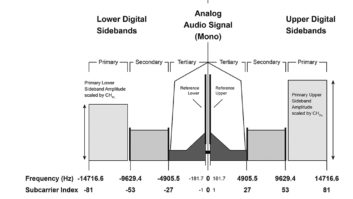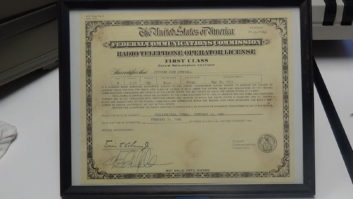Past and Present

This shot from 1950 features Lee Frischknecht sitting in the control room at what is now Utah State University. Bill Mountjoy, in his letter to the editor on Aug. 14 (Reader’s Forum, “Walk Down Memory Lane”), wrote that the Gates Model 51CS Studioette is so rare, its photo isn’t found on the Internet. Fortunately for me, I can enjoy the view from my desk!
As we are celebrating our 60th anniversary at Utah Public Radio, we have on display our original Gates Model 51CS Studioette console, dating from our carrier current days of 1949, along with our original American DT-4 microphone. Please find now-and-then photos attached.
The photo from 1950 has Lee Frischknecht, the future second president of National Public Radio, sitting at the controls as a member of the Radio guild at Utah State Agricultural College (now Utah State University).
Remembering where we’ve come from yesterday is part of knowing where we will be headed tomorrow.
Friend S. Weller, CBRE
Chief Engineer
Utah Public Radio
Logan, Utah
Not a Fan of IBOC
Please, give me a break! This is no better than giving iBiquity a free infomercial in Radio World (“AM Radio, Where Do We Go From Here?”). AM was never designed to handle digital transmission, period! All that IBOC does is clutter and jam an already damaged AM band. AM IBOC should have never been approved by the FCC in the first place. AM IBOC splatters many channels down from the host frequency. It’s a disaster.
Peter Q. George
President/General Manager
WXRB(FM)
Whitman, Mass.
Agreed on Meter Disagreement
I couldn’t agree more with Wisconsin Public Radio’s Steve Johnson’s conclusions and contentions in “With Meters, Don’t Agree to Disagree” (Sept. 11), which exposes the damage that can be caused by the reliance upon audio level indicating devices that are not what they seem.
As Mr. Johnson points out, there’s a vast difference in results between the synchronizing of two different kinds of sound level indicators via a steady (such as 1 kHz) tone, and then running a program through them, only to find that the indications no longer match each other’s.
The vu meter I described in May was designed to solve that problem in that an indicator conforming to ANSI specs would deliver readings identical to any other indicator that qualified as a “standard” vu meter. A manufacturer’s declaration that his indicator is a vu meter when it’s merely a voltmeter with a vu scale on it, or is an array of flashing lights, is doing the user a disservice, as Mr. Johnson found out.
Sadly, he’s forced to work with what he’s given. But as I pointed out in “VU Meter Legacy Shines On” (May 8), he can do something about it by adding a true vu meter to the output of each mixer and depending upon it for reliable, uniform sound level indications throughout his broadcast facility.
Finally, a word about so-called PPM (peak program modulation, if you will) metering: The analog meters are actually old-style dB meters with expanded scales. They were resurrected with the advent of rock n’ roll music in order to catch the fast-rise-time peaks generated by guitars and other “heavy metal” instruments (read: drums). There is no uniformity among the various incarnations (meters and flashing lightbulbs — either vs. each category or within a category), of such indicators.
And it has been immediately apparent to folks like Mr. Johnson that a principal drawback to the PPM meter is that it reads peaks and doesn’t reveal what the bulk of the program material is doing as long as there’s “peaking” going on.
The standard vu meter was created to solve this problem. Long may it “wave.”
Oliver Berliner
SounDesign Engineers
Beverly Hills, Calif.
Thanks for the ‘Freebie’ Advice
Thanks for the great article by Mark Lapidus in the Sept. 11 Radio World (“Stop With the Freebies”). We as an industry have “given it away” (whatever it is) for too long. Reaching our listeners and readers should have a profit motive behind it not only for our advertisers but for us, too!
Randal J. Miller
President
Miller Media Group
Taylorville, Ill.











